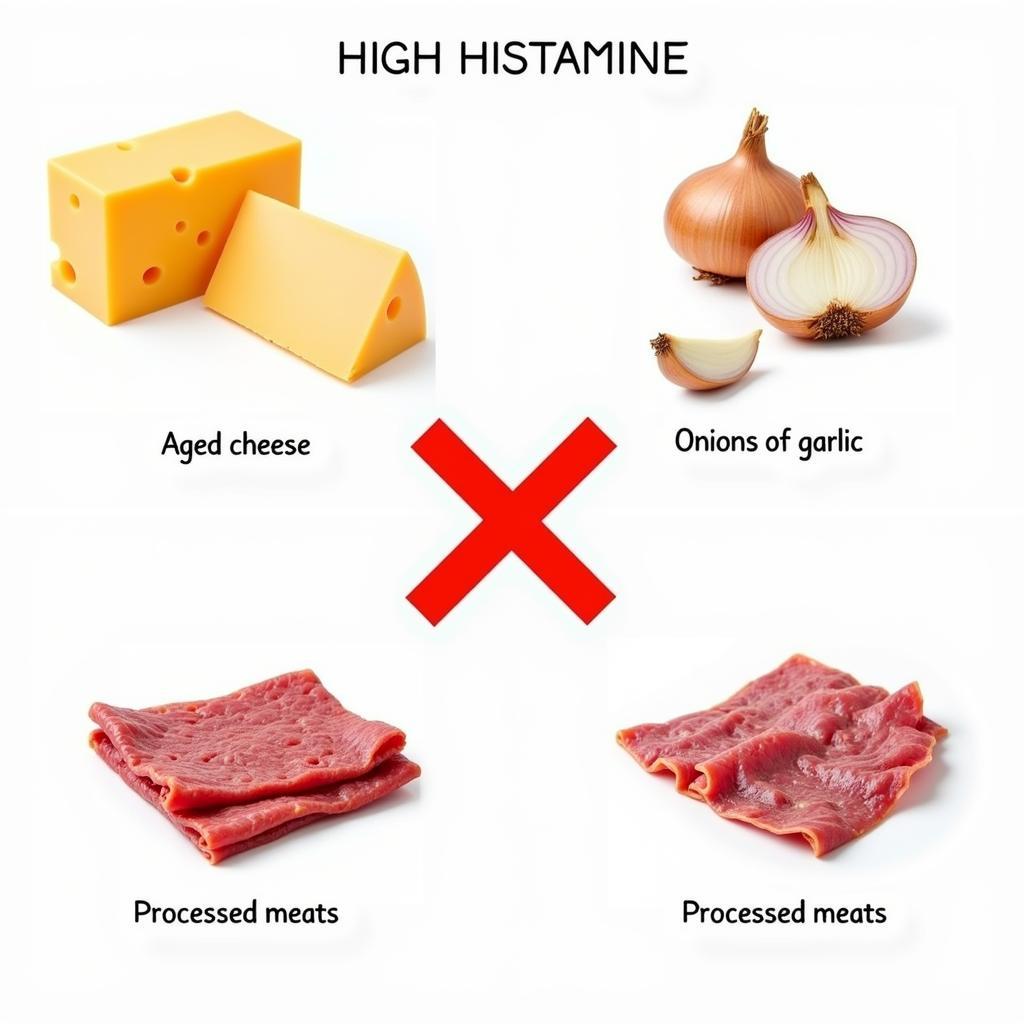A low histamine low FODMAP diet can feel restrictive, but with the right Low Histamine Low Fodmap Food List, it doesn’t have to be. Navigating these dietary restrictions can be challenging, but understanding the basics and having a comprehensive food list can make a world of difference in managing symptoms and enjoying delicious, healthy meals.
Understanding Low Histamine and Low FODMAP Diets
What is Histamine Intolerance?
Histamine intolerance occurs when your body has difficulty breaking down histamine, a compound found naturally in many foods. This can lead to a variety of symptoms, including headaches, hives, digestive issues, and nasal congestion. Managing histamine levels through diet is a key strategy for alleviating these symptoms.
What is a Low FODMAP Diet?
FODMAPs are a group of carbohydrates (fermentable oligosaccharides, disaccharides, monosaccharides, and polyols) that are poorly absorbed in the small intestine. For those with Irritable Bowel Syndrome (IBS) or other digestive sensitivities, FODMAPs can trigger symptoms like bloating, gas, and abdominal pain. A low FODMAP diet helps identify trigger foods and reduce these uncomfortable symptoms.
Navigating the Low Histamine Low FODMAP Food List
Combining both diets requires careful planning. This low histamine low FODMAP food list will help you make informed choices. Remember to consult with a registered dietitian or healthcare professional for personalized advice tailored to your specific needs.
Safe Foods to Enjoy
- Proteins: Freshly cooked chicken, turkey, and fish (avoid canned or cured).
- Grains: Rice noodles, quinoa, and oats.
- Fruits: Bananas (ripe), blueberries, and cantaloupe (in moderation).
- Vegetables: Carrots, zucchini, and spinach.
- Dairy Alternatives: Coconut milk (unsweetened) and rice milk.
Foods to Avoid
- High Histamine Foods: Aged cheese, fermented foods, smoked meats, spinach (in large quantities), and citrus fruits.
- High FODMAP Foods: Onions, garlic, wheat, dairy products, and apples.
 Foods to Avoid on a Low Histamine Low FODMAP Diet
Foods to Avoid on a Low Histamine Low FODMAP Diet
Tips for Low Histamine Low FODMAP Meal Planning
- Fresh is Best: Prioritize fresh, unprocessed ingredients.
- Read Labels Carefully: Check for hidden histamines and FODMAPs.
- Keep a Food Diary: Track your symptoms and identify trigger foods.
- Start Slowly: Gradually introduce new foods to monitor your tolerance.
“When starting a low histamine low FODMAP diet, patience and consistency are key,” says registered dietitian, Emily Carter, RD. “Don’t get discouraged by initial challenges. Focus on incorporating safe foods and gradually expanding your options.”
Low Histamine Low FODMAP Recipes
While it might seem limiting, there are plenty of delicious recipes you can enjoy. Simple meals like chicken and rice noodles with zucchini and fresh basil, or quinoa with baked chicken and carrots offer flavor and variety.
Conclusion
Following a low histamine low FODMAP food list can significantly improve your quality of life if you’re managing histamine intolerance and digestive sensitivities. Remember, finding the right balance and a personalized approach are crucial. By incorporating these guidelines and working with a healthcare professional, you can create a sustainable and enjoyable dietary plan that supports your health and well-being.
FAQ
- What are common symptoms of histamine intolerance? Common symptoms include headaches, skin rashes, digestive issues, and nasal congestion.
- How long should I stay on a low FODMAP diet? A low FODMAP diet typically has an elimination phase of 2-6 weeks followed by a reintroduction phase.
- Can I eat any fruit on a low histamine low FODMAP diet? Yes, some fruits like ripe bananas, blueberries, and cantaloupe (in moderation) are generally well-tolerated.
- What are some good protein sources for this diet? Freshly cooked chicken, turkey, and fish are excellent choices.
- Where can I find more low histamine low FODMAP recipes? Check out our recipe section on Mina Cones Food for delicious and easy meal ideas.
- Is it necessary to consult a dietitian for this diet? Consulting a registered dietitian is highly recommended for personalized guidance.
- How do I know if a food is low in histamine? Refer to reputable low histamine food lists and consult with a dietitian.
For support, please contact us at Phone: 02437655121, Email: minacones@gmail.com or visit us at 3PGH+8R9, ĐT70A, thôn Trung, Bắc Từ Liêm, Hà Nội, Việt Nam. We have a 24/7 customer service team.
“Finding the right balance of nutrients while managing these dietary restrictions can be challenging. Working with a dietitian can ensure you’re meeting your nutritional needs,” adds nutritionist, Dr. Sarah Johnson.